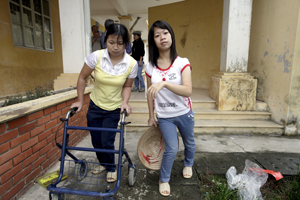Journalists expose the legacy of Agent Orange
Dec. 17, 2010 -- A campus-based journalism project is showing that the toxic effects of a defoliant used by U.S. forces during the Vietnam War continues to cause serious illness and physical deformities among generations of Vietnamese.

Young women whose disabilities are assumed to be the result of Agent Orange receive physical therapy and vocational training at Friendship Village in Hanoi. Credit: Nick Ut, AP, for the Vietnam Reporting Project
The Vietnam Reporting Project, a program of the Renaissance Journalism Center at SF State and headed by Professor of Journalism Jon Funabiki, commissioned 15 journalists to travel to Vietnam to report on Agent Orange's long-term impact on human health and related social justice issues. Project fellows include SF State journalism faculty and students, as well as Pulitzer Prize-winning journalists and photographers from across the U.S.
Used by American forces in Vietnam to defoliate jungles and expose enemy troops, Agent Orange contained dioxin, a highly toxic pollutant with proven links to cancer and birth defects. According to the Vietnam Red Cross, an estimated 3 million people in Vietnam suffer health problems directly linked to the toxin.
"It's a very underreported story," Funabiki said. "I was shocked and felt very ignorant when I learned that Agent Orange was still affecting people three generations after the war." Children and grandchildren of people exposed to Agent Orange during its use from 1961 to 1970 have been and continue to be born with missing limbs, blindness and cancers linked to the exposure. Funabiki hopes that the project reporting will reach Vietnamese American communities in particular, where he believes lingering bitterness over the war has prevented open discussions about the effects of Agent Orange.
Bay Area broadcast journalist K. Oanh Ha profiled Bay Area Vietnamese soldiers who fought alongside Americans and came to the U.S. as refugees, but who are not eligible for the same medical assistance. According to her three-part radio series, "The Forgotten Ones: The Legacy of Agent Orange," which aired in November on KQED radio's California Report, American Vietnam War veterans have received nearly $2 billion in federal disability payments for treatment of problems linked to Agent Orange.
SF State journalism students Laura Waxmann and Tara Haghighi traveled to Vietnam with Assistant Professor of Journalism Yumi Wilson last August. They interviewed and photographed some of the estimated 150,000 Vietnamese people born with birth defects including blindness, Down Syndrome and missing or deformed limbs. Their articles, published by the San Francisco Chronicle in October, reported on the cultural and social barriers that keep the disabled in Vietnam from leading more independent lives. Vietnam is developing its first legislation requiring equal access to education, health care, public transportation and cultural and sports events for disabled persons.
"The trip (to Vietnam) allowed us to address very important things, like language barriers and how to keep up your stamina while covering difficult stories," Wilson said. "These things are not easily taught in the classroom."
Wilson and the students also photographed the SF State affiliated Whirlwind Wheelchair factory in Vietnam.
Among the other journalists selected for the project who have already filed stories is Thuy Vu, who created two stories focused on Vietnamese soldiers sickened by Agent Orange for KPIX TV, where she is a news anchor. Other projects include news, multimedia and photojournalism pieces from Connie Schultz of the Cleveland Plain Dealer, Alumn Sean Connelley of the Los Angeles Times, alumn and independent broadcast journalist Nguyen Qui Duc, photojournalist Catherine Karnow and Associated Press photojournalist (Nick) Ut Cong Huynh, who won a Pulitzer Prize for his iconic photograph of a nine-year old Vietnamese girl severely burned by a napalm bomb.
The Renaissance Journalism Center, which operates in collaboration with the nonprofit ZeroDivide, developed the Vietnam Reporting Project in collaboration with Asian American & Pacific Islanders in Philanthropy. The project was funded by the Ford Foundation.
Share this story:
